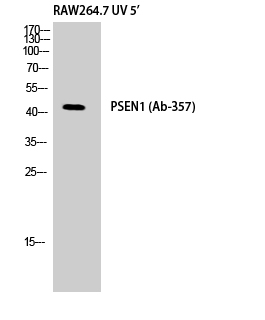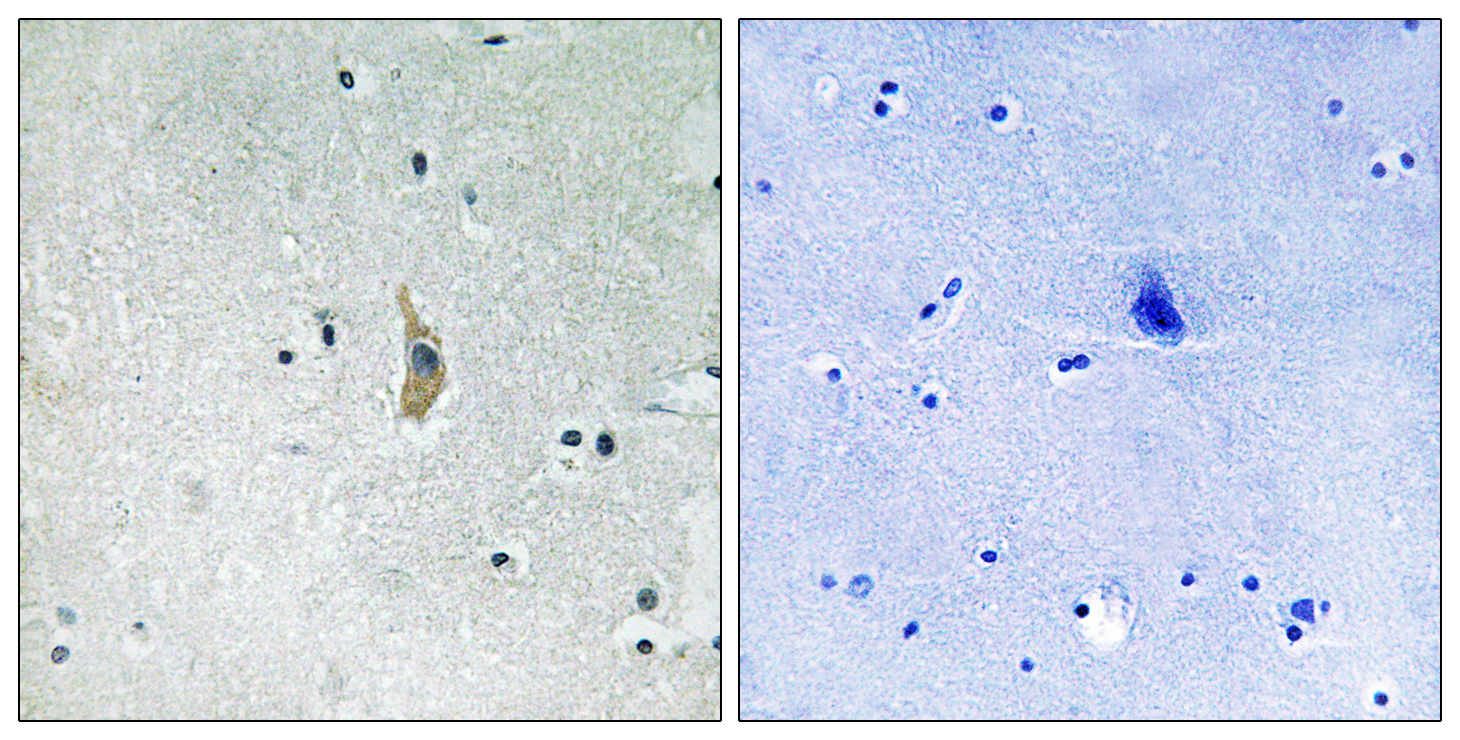Presenilin 1 Polyclonal Antibody
- 货号:YT3856
- 应用:WB;IHC;IF;ELISA
- 种属:Human;Mouse;Rat
- 简介:
- >>Wnt signaling pathway;>>Notch signaling pathway;>>Neurotrophin signaling pathway;>>Alzheimer disease;>>Pathways of neurodegeneration - multiple diseases;>>Human papillomavirus infection
- 免疫原:
- The antiserum was produced against synthesized peptide derived from human PSEN1. AA range:323-372
- 特异性:
- Presenilin 1 Polyclonal Antibody detects endogenous levels of Presenilin 1 protein.
- 组成:
- Liquid in PBS containing 50% glycerol, 0.5% BSA and 0.02% sodium azide.
- 来源:
- Polyclonal, Rabbit,IgG
- 稀释:
- WB 1:500 - 1:2000. IHC 1:100 - 1:300. ELISA: 1:5000.. IF 1:50-200
- 纯化工艺:
- The antibody was affinity-purified from rabbit antiserum by affinity-chromatography using epitope-specific immunogen.
- 储存:
- -15°C to -25°C/1 year(Do not lower than -25°C)
- 其他名称:
- PSEN1;AD3;PS1;PSNL1;Presenilin-1;PS-1;Protein S182
- 背景:
- Alzheimer's disease (AD) patients with an inherited form of the disease carry mutations in the presenilin proteins (PSEN1; PSEN2) or in the amyloid precursor protein (APP). These disease-linked mutations result in increased production of the longer form of amyloid-beta (main component of amyloid deposits found in AD brains). Presenilins are postulated to regulate APP processing through their effects on gamma-secretase, an enzyme that cleaves APP. Also, it is thought that the presenilins are involved in the cleavage of the Notch receptor, such that they either directly regulate gamma-secretase activity or themselves are protease enzymes. Several alternatively spliced transcript variants encoding different isoforms have been identified for this gene, the full-length nature of only some have been determined. [provided by RefSeq, Aug 2008],
- 功能:
- disease:Defects in PSEN1 are a cause of Alzheimer disease type 3 (AD3) [MIM:607822]. AD3 is a familial early-onset form of Alzheimer disease. Alzheimer disease is a neurodegenerative disorder characterized by progressive dementia, loss of cognitve abilities, and deposition of fibrillar amyloid proteins as intraneuronal neurofibrillary tangles, extracellular amyloid plaques and vascular amyloid deposits. The major constituent of these plaques is the neurotoxic amyloid-beta-APP 40-42 peptide (s), derived proteolytically from the transmembrane precursor protein APP by sequential secretase processing. The cytotoxic C-terminal fragments (CTFs) and the caspase-cleaved products such as C31 derived from APP, are also implicated in neuronal death.,disease:Defects in PSEN1 are a cause of frontotemporal dementia [MIM:600274].,domain:The PAL motif is required for normal active site conformation.,fun
- 细胞定位:
- Endoplasmic reticulum . Endoplasmic reticulum membrane ; Multi-pass membrane protein . Golgi apparatus membrane ; Multi-pass membrane protein . Cytoplasmic granule . Cell membrane ; Multi-pass membrane protein . Cell projection, growth cone . Early endosome . Early endosome membrane ; Multi-pass membrane protein . Cell projection, neuron projection . Cell projection, axon . Cell junction, synapse . Translocates with bound NOTCH1 from the endoplasmic reticulum and/or Golgi to the cell surface (PubMed:10593990). Colocalizes with CDH1/2 at sites of cell-cell contact. Colocalizes with CTNNB1 in the endoplasmic reticulum and the proximity of the plasma membrane (PubMed:9738936). Also present in azurophil granules of neutrophils (PubMed:11987239). Colocalizes with UBQLN1 in the cell membrane and
- 组织表达:
- Detected in azurophile granules in neutrophils and in platelet cytoplasmic granules (at protein level) (PubMed:11987239). Expressed in a wide range of tissues including various regions of the brain, liver, spleen and lymph nodes (PubMed:7596406, PubMed:8641442, PubMed:8574969).

- Western Blot analysis of RAW264.7 UV 5' cells using Presenilin 1 Polyclonal Antibody

- Immunohistochemistry analysis of paraffin-embedded human brain tissue, using PSEN1 Antibody. The picture on the right is blocked with the synthesized peptide.

- Western blot analysis of lysates from Raw264.7 cells, treated with UV 5', using PSEN1 Antibody. The lane on the right is blocked with the synthesized peptide.




